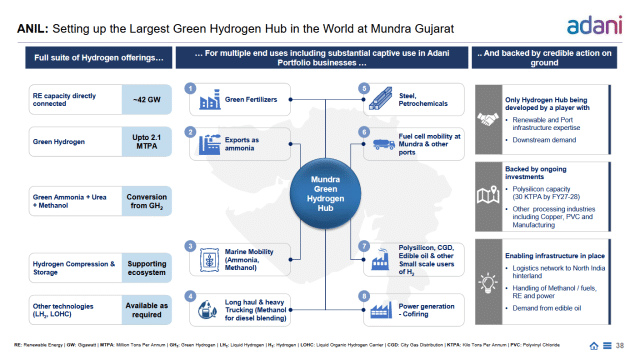Adani: critical transmission infrastructure approved for Gujarat ammonia project
By Julian Atchison on April 22, 2025
$330 million upgrades to be completed by 2028
Adani Energy Solutions, the Adani Group’s electricity transmission and distribution arm, has had a critical project approved that will supply power to its renewable hydrogen and ammonia project in Mundra, Gujarat. At a cost of $330 million, the upgrades include adding substation transformers, a 75km transmission line to connect substations and reinforce the nearby grid.

Click to expand. Details of the renewable hydrogen hub in Mundra, Gujarat, including ammonia production for co-firing, marine fuel and exports. From Adani Enterprises Limited Investor Presentation (March 2025).
Details of the Mundra project are limited, but Indian media reports plans for a four-five phase project. The first phase will be a 1 million tons per year hydrogen production capacity, built in two 500,000 ton-capacity blocks. $4 billion will be invested in equipment, infrastructure and balance of plant at the Mundra Green Hydrogen Hub.
Among the end-uses for hydrogen, ammonia will be utilized for coal co-firing (potentially at the nearby Adani Mundra power plant), marine fuel, export to Japan, Korea, and the EU, and as a substitute for current ammonia imports to India. Import substitution in particular represents a “low-hanging fruit” opportunity in India, with a significant amount of annual government funding currently granted to fertilizer producers to subsidize the cost of importing ammonia feedstock.
The Mundra Hub will also feature future manufacturing of wind, solar and electrolysis components. Adani estimates that LCOH for electrolytic hydrogen at Mundra could be lower than anywhere else in India, driven by existing onsite transmission infrastructure, Adani’s significant renewable electricity generating assets (as well as one of the lowest LOCEs in India), and the anticipated scale of installed electrolysis.
Transmission for electrolytic hydrogen projects remains a key project development step in India. This January, AM Green secured approval to connect its renewable ammonia mega-project in Kakinada to India’s national grid. In July 2024 the World Bank announced it would provide $1.5 billion to assist (amongst other items) the waiver of interstate transmission charges for electrolytic hydrogen projects in India. And Indian government authorities at a national and state level have made electricity and transmission-related incentives central to new hydrogen policy programs.